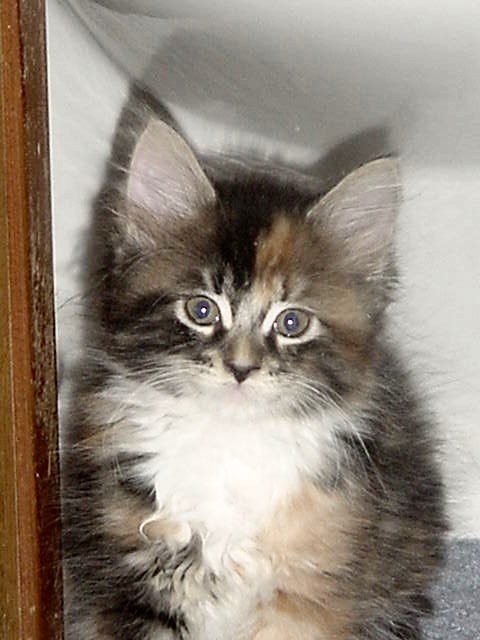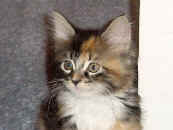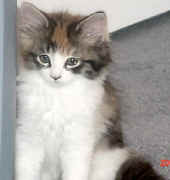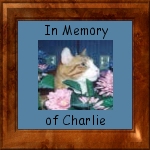 Myths, legend and lore surround the Maine
Coon Cat. Some are amusing, some are fantastic flights of fantasy and some are
merely plausible. They certainly provide good material for conversation. Books
and articles dealing with these aspects of the Maine Coon Cat have been well
received, as people never seem to tire of the subject and are always eager to
know more about this wonderful breed.
Myths, legend and lore surround the Maine
Coon Cat. Some are amusing, some are fantastic flights of fantasy and some are
merely plausible. They certainly provide good material for conversation. Books
and articles dealing with these aspects of the Maine Coon Cat have been well
received, as people never seem to tire of the subject and are always eager to
know more about this wonderful breed.
 The Maine Coon is the native American
longhaired cat and was recognized as a specific breed in Maine where they were
held in high regard for their mousing talents. Through nature’s own breeding
program, this breed has developed into a sturdy cat ideally suited to the harsh
winters and varied seasons of the region. The Maine Coon is well known for its
loving nature, kindly disposition and great intelligence. Maines are especially
good with children and dogs and have always been a popular and sought after
companion.
The Maine Coon is the native American
longhaired cat and was recognized as a specific breed in Maine where they were
held in high regard for their mousing talents. Through nature’s own breeding
program, this breed has developed into a sturdy cat ideally suited to the harsh
winters and varied seasons of the region. The Maine Coon is well known for its
loving nature, kindly disposition and great intelligence. Maines are especially
good with children and dogs and have always been a popular and sought after
companion.
 The Maine Coon has always been admired for
its beauty, and a Maine Coon was chosen Best Cat at the first major cat show
ever held in this country. The transition from easygoing farm cat to CFA
finalist was not an easy one, nor did it happen quickly. Although they lost
favor and were conspicuously absent from shows for quite a long time, we are now
seeing large classes of these beauties in most cat shows and it is not unusual
for a Maine Coon to be named “Best Cat.”
The Maine Coon has always been admired for
its beauty, and a Maine Coon was chosen Best Cat at the first major cat show
ever held in this country. The transition from easygoing farm cat to CFA
finalist was not an easy one, nor did it happen quickly. Although they lost
favor and were conspicuously absent from shows for quite a long time, we are now
seeing large classes of these beauties in most cat shows and it is not unusual
for a Maine Coon to be named “Best Cat.”
 Pricing on Maine Coons usually depends on
type, applicable markings and bloodlines distinguished by Grand Champion (GC),
National or Regional winning parentage (NW or RW) or of Distinguished Merit
parentage (DM). The DM title is achieved by the dam (mother) having produced
five CFA grand champion/premier (alter) or DM offspring, or sire (father) having
produced fifteen CFA grand champion/premier or DM offspring. Usually breeders
make available kittens between twelve and sixteen weeks of age. After twelve
weeks, kittens have had their basic inoculations and developed the physical and
social stability needed for a new environment, showing, or being transported by
air. Keeping such a rare treasure indoors, neutering or spaying and providing
acceptable surfaces (e.g. scratching posts) for the natural behavior of
scratching (CFA disapproves of declawing or tendonectomy surgery) are essential
elements for maintaining a healthy, long and joyful life.
Pricing on Maine Coons usually depends on
type, applicable markings and bloodlines distinguished by Grand Champion (GC),
National or Regional winning parentage (NW or RW) or of Distinguished Merit
parentage (DM). The DM title is achieved by the dam (mother) having produced
five CFA grand champion/premier (alter) or DM offspring, or sire (father) having
produced fifteen CFA grand champion/premier or DM offspring. Usually breeders
make available kittens between twelve and sixteen weeks of age. After twelve
weeks, kittens have had their basic inoculations and developed the physical and
social stability needed for a new environment, showing, or being transported by
air. Keeping such a rare treasure indoors, neutering or spaying and providing
acceptable surfaces (e.g. scratching posts) for the natural behavior of
scratching (CFA disapproves of declawing or tendonectomy surgery) are essential
elements for maintaining a healthy, long and joyful life.
There are CFA clubs devoted to the
promotion, protection and preservation of the Maine Coon breed. For more
information, please send inquiries to CFA, PO Box 1005, Manasquan NJ 08736-0805.


www.maine-coon-cats.org
-- General resource of breeders, rescues and clubs, including a selection of
pictures of Maine Coon Cats and informational links.
Last
updated:
12/11/10
 Myths, legend and lore surround the Maine
Coon Cat. Some are amusing, some are fantastic flights of fantasy and some are
merely plausible. They certainly provide good material for conversation. Books
and articles dealing with these aspects of the Maine Coon Cat have been well
received, as people never seem to tire of the subject and are always eager to
know more about this wonderful breed.
Myths, legend and lore surround the Maine
Coon Cat. Some are amusing, some are fantastic flights of fantasy and some are
merely plausible. They certainly provide good material for conversation. Books
and articles dealing with these aspects of the Maine Coon Cat have been well
received, as people never seem to tire of the subject and are always eager to
know more about this wonderful breed. The Maine Coon is the native American
longhaired cat and was recognized as a specific breed in Maine where they were
held in high regard for their mousing talents. Through nature’s own breeding
program, this breed has developed into a sturdy cat ideally suited to the harsh
winters and varied seasons of the region. The Maine Coon is well known for its
loving nature, kindly disposition and great intelligence. Maines are especially
good with children and dogs and have always been a popular and sought after
companion.
The Maine Coon is the native American
longhaired cat and was recognized as a specific breed in Maine where they were
held in high regard for their mousing talents. Through nature’s own breeding
program, this breed has developed into a sturdy cat ideally suited to the harsh
winters and varied seasons of the region. The Maine Coon is well known for its
loving nature, kindly disposition and great intelligence. Maines are especially
good with children and dogs and have always been a popular and sought after
companion. The Maine Coon has always been admired for
its beauty, and a Maine Coon was chosen Best Cat at the first major cat show
ever held in this country. The transition from easygoing farm cat to CFA
finalist was not an easy one, nor did it happen quickly. Although they lost
favor and were conspicuously absent from shows for quite a long time, we are now
seeing large classes of these beauties in most cat shows and it is not unusual
for a Maine Coon to be named “Best Cat.”
The Maine Coon has always been admired for
its beauty, and a Maine Coon was chosen Best Cat at the first major cat show
ever held in this country. The transition from easygoing farm cat to CFA
finalist was not an easy one, nor did it happen quickly. Although they lost
favor and were conspicuously absent from shows for quite a long time, we are now
seeing large classes of these beauties in most cat shows and it is not unusual
for a Maine Coon to be named “Best Cat.” Pricing on Maine Coons usually depends on
type, applicable markings and bloodlines distinguished by Grand Champion (GC),
National or Regional winning parentage (NW or RW) or of Distinguished Merit
parentage (DM). The DM title is achieved by the dam (mother) having produced
five CFA grand champion/premier (alter) or DM offspring, or sire (father) having
produced fifteen CFA grand champion/premier or DM offspring. Usually breeders
make available kittens between twelve and sixteen weeks of age. After twelve
weeks, kittens have had their basic inoculations and developed the physical and
social stability needed for a new environment, showing, or being transported by
air. Keeping such a rare treasure indoors, neutering or spaying and providing
acceptable surfaces (e.g. scratching posts) for the natural behavior of
scratching (CFA disapproves of
Pricing on Maine Coons usually depends on
type, applicable markings and bloodlines distinguished by Grand Champion (GC),
National or Regional winning parentage (NW or RW) or of Distinguished Merit
parentage (DM). The DM title is achieved by the dam (mother) having produced
five CFA grand champion/premier (alter) or DM offspring, or sire (father) having
produced fifteen CFA grand champion/premier or DM offspring. Usually breeders
make available kittens between twelve and sixteen weeks of age. After twelve
weeks, kittens have had their basic inoculations and developed the physical and
social stability needed for a new environment, showing, or being transported by
air. Keeping such a rare treasure indoors, neutering or spaying and providing
acceptable surfaces (e.g. scratching posts) for the natural behavior of
scratching (CFA disapproves of 
